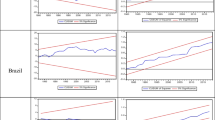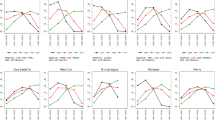Abstract
The objective of this paper is to develop a GME formulation for the class of spatial structural equations models (S-SEM). In this respect, two innovatory aspects are introduced: (i) the formalization of the GME estimation approach for structural equations models that account for spatial heterogeneity and spatial dependence; (ii) the extension of the methodology to a panel data framework. We also present an application of the method to real data finalized to investigate disparities of unemployment rates in OECD countries over the period 1998-2006.
Similar content being viewed by others
References
AL-NASSER, A.D. (2003), “Customer Satisfaction Measurement Models: Generalized Maximum Entropy Approach”, Pakistan Journal of Statistics, 19(2), 213–226.
ANSELIN, L. (1988), Spatial Econometrics: Methods and Models, Dordrecht, The Netherlands: Kluwer.
ANSELIN L. (2001), “Spatial Econometrics”, in A Companion to Theoretical Econometrics, ed. B.H. Baltagi, Malden: Blackwell, pp. 310–330.
BERNARDINI PAPALIA, R. (2006), “Modeling Mixed Spatial Processes and Spatio-Temporal Dynamics in Information Theoretic Frameworks”, in COMPSTAT 2006, eds. A. Rizzi and M. Vichi, New York: Physica Verlag Heidelberg, pp. 1483–1491.
BERNARDINI PAPALIA, R. (2008a), “A Composite Generalized Cross Entropy Formulation in Small Samples Estimation”, Econometric Reviews, 27, 596–609.
BERNARDINI PAPALIA, R. (2008b), “Analyzing Trade Dynamics from Incomplete Data in Spatial Regional Models: A Maximum Entropy Approach”, in Bayesian Inference And Maximum Entropy Methods in Science and Engineering, eds. L. De Souza, C.A. Braganca Pereira, and J.M. Stern, New York: American Institute of Physics, 1073, pp. 325–331.
BOLLEN, K.A. (1989), Structural Equations with Latent Variables, New York: John Wiley and Sons.
CIAVOLINO, E., and DAHLGAARD, J.J. (2007), “ECSI - Customer Satisfaction Modelling and Analysis: A Case Study”, Total Quality Management & Business Excellence, 18 (5), 545–554.
CIAVOLINO, E., and DAHLGAARD, J.J. (2009), “Simultaneous Equation Model based on Generalized Maximum Entropy for Studying the Effect of the Management’s Factors on the Enterprise Performances”, Journal of Applied Statistics, 36 (7), 801–815.
CIAVOLINO, E., and AL-NASSER, A.D. (2009), “Comparing Generalized Maximum Entropy and Partial Least Squares Methods for Structural Equation Models”, Journal of Nonparametric Statistics, 21 (8), 1017–1036.
DUNCAN, O.D. (1975), Introduction to Structural Equation Models, New York: Academic Press.
FORNELL, C., and BOOKSTEIN, F.L. (1982), “Two Structural Equation Models: LISREL and PLS Applied to Consumer Exit-Voice Theory”, Journal of Marketing Research, 19 (4), 440–452.
GOLAN, A. (2008), “Information and Entropy Econometrics — A Review and Synthesis”, Foundations and Trends in Econometrics, 2, Nos. 1–2, 1–145.
GOLAN, A., JUDGE, G., and MILLER, D. (1996), Maximum Entropy Econometrics: Robust Estimation with Limited Data, New York: Wiley.
JÖRESKOG, K.G. (1973), “A General Method of Estimating a Linear Structural Equation System”, in Structural Equation Models in the Social Sciences, eds. S.A. Goldberg, and D.O. Duncan, New York: Seminar Press, pp. 85–112.
KELEJIAN, H.H., and PRUCHA, I.R. (1999), “A Generalized Moments Estimator for the Autoregressive Parameter in a Spatial Model”, International Economic Review, 40, 509–533.
LESAGE, J.P., and PACE, R.K. (2004), “Spatial and Spatiotemporal Econometrics”, in Advances in Econometrics (Vol. 18), Oxford: Elsevier Ltd, pp. 1–32.
MOLHO, I. (1995), “Spatial Autocorrelation in British Unemployment”, Journal of Regional Science, 35, 641–658.
OVERMAN, H., and PUGA, D. (2002), “Unemployment Clusters Across European Regions and Countries”, Economic Policy, 34, 115–147.
PATACCHINI, E., and ZENOU, Y. (2007), “Spatial Dependence in Local Unemployment Rates”, Journal of Economic Geography, 7, 169–191.
PUKELSHEIM, F. (1994), “The Three Sigma Rule”, The American Statistician, 48(2), 88–91.
SHANNON, C.E., (1948), “A Mathematical Theory of Communication”, Bell System Technical Journal, 27, 379–423.
Author information
Authors and Affiliations
Corresponding author
Rights and permissions
About this article
Cite this article
Bernardini Papalia, R., Ciavolino, E. GME Estimation of Spatial Structural Equations Models. J Classif 28, 126–141 (2011). https://doi.org/10.1007/s00357-011-9073-0
Published:
Issue Date:
DOI: https://doi.org/10.1007/s00357-011-9073-0




